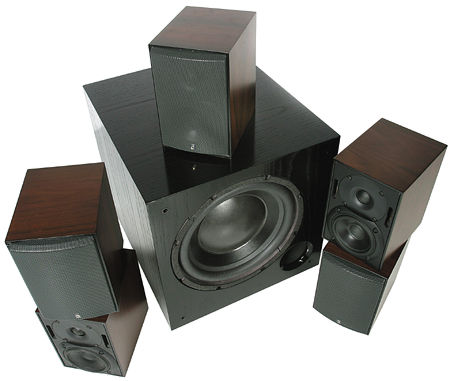Alón by Acarian Napoleon Surround Speaker System

The Napoleon system comprises of five diminutive, identical satellites and a subwoofer. Each shielded 2-way satellite weighs a mere 10 pounds and comes in attractive Brazilian Santos Rosewood or Black Ash veneers, with a metal mesh grille. The 41/2-inch bilaminate woofer crosses over to the 1-inch silk-dome tweeter at 3.5kHz through a hand-wired network that uses an air-core inductor and polypropylene capacitors. Driver quality and cabinet construction are good.
The Thunderbolt is a compact, 85-pound, front-vented subwoofer with a custom 12-inch, ultra-long-excursion, Kevlar-reinforced pulp-cone driver with a cast frame and massive double-stacked magnet. The sub is driven by a discrete, class-A/B non-servo amplifier, the power of which is not specified.
The Thunderbolt is rated from below 20Hz to 160Hz. Alón recommends it for use with its far more expensive systems, so I figured it was well up to the task of partnering the Napoleon satellites. The sub's rear panel has an output-level control, a lowpass filter continuously variable from 40Hz to 160Hz (the highpass filter is fixed at 125Hz), a variable 0–180° phase control, one set each of high-level input and output speaker binding posts, and 2-channel line inputs and outputs. The amplifier sits in a separate MDF cabinet within the main cabinet.
The Thunderbolt's build quality and overall fit and finish are excellent. The cabinet is made of 1-inch-thick MDF and is glued with wood adhesive rather than the hot melt glue used for most subwoofers. The sides are pressure-clamped during drying; this, together with the cabinet's dual front baffle, ensures excellent rigidity. Based on the ol' knuckle-rap test, the enclosure seemed very well-braced and -constructed.
The 12-inch driver has a massive cast basket and magnet assembly. The relatively light, Kevlar-reinforced cone of natural-fiber pulp provides excellent stiffness, greater efficiency, and is easier for an amplifier to control. Alón maintains that a high-mass driver's greater inertia takes longer to start and stop, thereby interfering with bass transients. Designer Carl Marchisotto doesn't use servos in his subs because he claims that, no matter how fast the servo, by the time it has compared input with output and applied its correction, the woofer is reproducing the next cycle, which leads to compression and loss of transient clarity.
Setup
Carl Marchisotto paid me a visit to set up the Napoleon system. He set one pair of satellites on rigid stands on either side of my monitor, and another pair at opposite ends of my couch in the rear, all at approximately ear height. A single Napoleon was placed atop my 65-inch Hitachi RPTV and aimed down toward the listening position. That tiny tot sure looked lost. Marchisotto pulled the Thunderbolt subwoofer away from the front wall and angled it slightly into the room. As usual, I let the manufacturer do his thing, then did mine after he'd left. The sub eventually ended up in my customary left-corner spot.
Marchisotto claims that the Napoleon system sounds best with the satellites driven full-range to avoid the preamp-processor's crossover, but as good as his speakers might be, they can't defy the laws of physics: I don't see or hear the value in trying to put very low frequencies through a 41/2-inch woofer if it can be avoided—especially in a home theater system, and especially if the preamp-processor has a high-quality internal crossover. In any case, if your processor can't simultaneously feed the bass to the subwoofer when set for Large speakers, you'll miss a great deal of bass information with satellites that can't go below 80Hz.
The trickiest part of setting up a small satellite-subwoofer system is getting the sub to blend with the sats without leaving a hole in the middle, or creating boominess and overhang in the crossover region. Alón recommends balancing the sub's output level with the main speakers before fine-tuning the crossover. Then, if your receiver or pre-pro offers only the THX standard 80Hz crossover, Alón recommends setting the Thunderbolt's variable lowpass filter to 160Hz to avoid a double crossover when using the Napoleons. Otherwise, Alón suggests setting the crossover in the electronics to 200Hz, then using the Thunderbolt's variable crossover to blend it with the satellites. Finally, you set the variable phase control (0–180°) to create the most coherent low-frequency picture. Alón smartly recommends a good recording of a bass drum to arrive at the most coherent sonic picture.
Listening
The star of the Alón Napoleon assemblage was the subwoofer. I've heard a lot of subs in my day, and the Thunderbolt was easily one of the most musical. It's a true subwoofer, capable of close to 20Hz response. Whether because of the cone material, the lack of a servo system, or both, the Thunderbolt was among the fastest, least colored subs I've heard. Even when required to deliver frequencies up to around 100Hz, the Thunderbolt neither gave away its location nor produced annoying "one-note" bass. Instead, it produced the combination of weight, coherence, and leading-edge detail that makes bass performance believable and appropriately sized. What's more, this relatively small box could play loud without strain or compression.
- Log in or register to post comments





























































